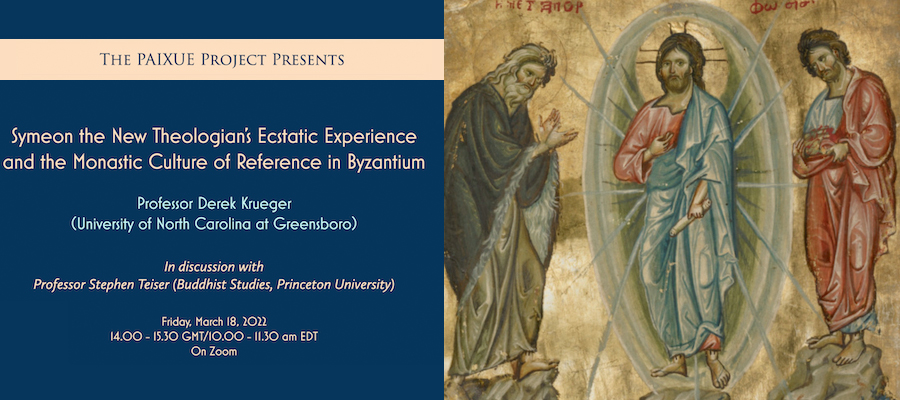Symeon the New Theologian's Ecstatic Experience and the Monastic Culture of Reference in Byzantium, lecture by Derek Krueger (University of North Carolina at Greensboro), PAIXUE Workshop, University of Edinburgh via Zoom, March 18, 2022, 2:00–3:30 PM (UK)
In discussion with Professor Stephen Teiser (Princeton University)
Byzantine accounts of ecstatic experience engage a culture of liturgical reference, where one ritual practice quotes or makes reference to another rite. Preaching to his monks while abbot of the Monastery of St. Mamas in Constantinople, Symeon the New Theologian (949-1022CE) described the mystical encounters of a certain George, whom Symeon’s biographer, editor, and would-be disciple, Niketas Stethatos (c1005-c1065), identified as the saint himself. In one episode, when he was about 20 and still a layman, George/Symeon achieved a vision of divine radiance that filled the room (Catechetical Discourses 22). He had for some time engaged in a nightly practice of reciting psalms and repeating “Lord, have mercy” before bed. One time, while groaning and tearful and rehearsing this rite of repentance “in his mind” rather than aloud, the room was flooded with light and he perceived himself merging with it and ascending toward a higher illumination. In this way a penitential rite performed internally served to open an extended perception of the divine. Later, while a novice monk of about 27, George/Symeon’s spiritual father instructed him to recite the Trisagion prayer, a quotation from the Divine Liturgy (Catechetical Discourses 16). Upon beginning “Holy God,” and “moved by tears and loving desire for God,” he fell upon the ground and perceived “a great light” shining on him. He seemed to be displaced and depersonalized, forgetting where and who he was. Once again he cried out repeatedly “Lord, have mercy.” Although Symeon does not specifically enjoin his monks to imitate these practices to induce similar states, he presents these episodes as models for his charges’ private piety. In both cases, the repetition of ritual texts provide entry into and perhaps sustain a period of mystical absorption. In the second instance the duration of the experience is unclear. This ritually induced participation in the light seems to queer time, space, body, and identity. Niketas’s renarration of these events demonstrate a later author’s attempt to set boundaries around such practices (Life of Symeon the New Theologian 5, 19).
The culture of Christian reference in Byzantium did not simply tag the Bible as a source of authority. Rather it made sustained reference to liturgy, connecting ritual act to ritual act as much as text to text. It may be useful to think of these as instances of interliturgicality rather than intertextuality. Gavin Flood has described how ascetics become “entextualisations” of their tradition. Expanding this to emphasize the sounds, postures, and interior dispositions of Byzantine religious culture suggests we consider more broadly the formation of liturgical subjects to see ascetics as embodiments of liturgy. In the tradition of comparative religion, dialogue with Stephen Teiser about rites of healing preserved in manuscripts from Dunhuang may offer insights about ritual quotations embedded in later rites.
Derek Krueger is Joe Rosenthal Excellence Professor of Religious Studies at the University of North Carolina at Greensboro. A historian of Christian culture in Late Antiquity and Byzantium, Professor Krueger has written extensively about the practice of Christianity in the pre-modern Eastern Mediterranean.
Advance registration required.
